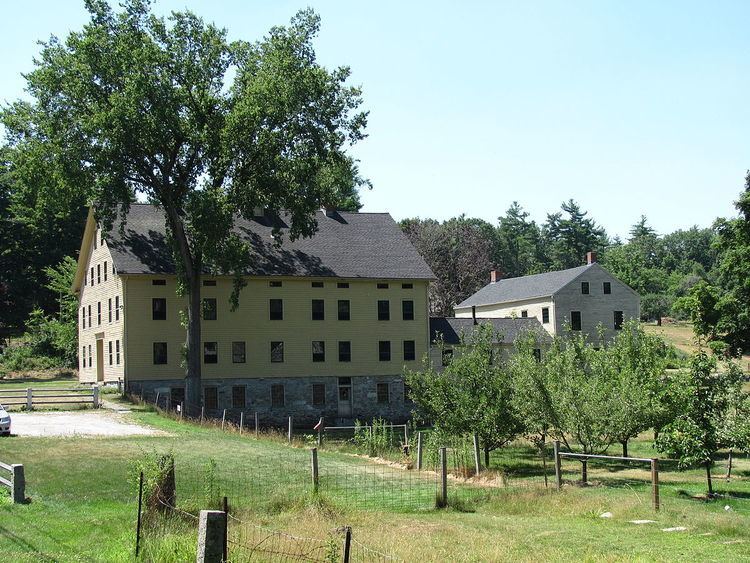 | ||
Template:Shakers
Contents
- The first Shaker societies
- Settlement growth
- Bishoprics
- Family groups
- Out families and short lived missions
- Shaker village tourism
- Museums
- References
After the Shakers arrived in the United States in 1774, they established numerous communities in the late-18th century through the entire 19th century. The first villages organized in Upstate New York and the New England states, and, through Shaker missionary efforts, Shaker communities appeared in the Midwestern states. Communities of Shakers were governed by area bishoprics and within the communities individuals were grouped into "family" units and worked together to manage daily activities. By 1836 eighteen major, long-term societies were founded, comprising some sixty families, and many smaller, short-lived communities were established over the course of the 19th century, including two failed ventures into the Southeastern United States and an urban community in Philadelphia, Pennsylvania. The Shakers peaked in population by the early 1850s. With the turmoil of the American Civil War and subsequent Industrial Revolution, Shakerism went into severe decline, and as the number of living Shakers diminished, Shaker villages ceased to exist. Some of their buildings and sites have become museums, and many are historic districts under the National Register of Historic Places. The only active community is Sabbathday Lake Shaker Village in Maine.
The first Shaker societies
The first Shaker community was established north of Albany, and was first called "Niskayuna", a rendering of the Indian name for the land. Later the town they were in was officially named Watervliet. That part of the town of Watervliet is now in the town of Colonie (since 1895), and the name Watervliet is now limited to the city of Watervliet (1896). In addition, Niskayuna is now the name of a town to the northwest. This has led to some confusion, because many historical accounts refer to them as the Niskayuna Shakers, while others refer to them as Watervliet Shakers. The Watervliet Shaker Historic District is where Mother Ann Lee was buried.
By 1780, the missionary work of the Shakers had attracted many new converts. An extensive series of trips throughout New England from 1781 through 1783 brought in followers across the entire region. Converts began appearing in New Lebanon and Canaan, New York; Hancock, Pittsfield, Richmond, Ashfield, Harvard, and Shirley, Massachusetts; and the states of Connecticut, New Hampshire, and Maine (then part of Massachusetts), among other locations.
In 1784, Ann Lee and her brother both died, leaving James Whittaker to lead the faith. By 1787, he too had died, and Joseph Meacham assumed the role as leader. Meacham appointed Lucy Wright of Pittsfield to co-lead, and under their auspices they organized a central Village in New Lebanon, as well as organizing the original settlement of Watervliet. By 1790, the Hancock Village was also organized.
After the formation of the New Lebanon, Watervliet, and Hancock communities, within three years all remaining Northeastern communities would organize in Massachusetts, Connecticut, New Hampshire, and Maine.
Settlement growth
The Shakers built more than 20 settlements that attracted at least 20,000 converts over the next century. Strict believers in celibacy, Shakers acquired their members through conversion, indenturing children, and adoption of orphans. Some children, such as Isaac N. Youngs, came to the Shakers when their parents joined, then grew up to become faithful members as adults.
As their communities grew, women and men shared leadership of the Shaker communities. Women preached and received revelations as the Spirit fell upon them. Thriving on the religious enthusiasm of the first and second Great Awakenings, the Shakers declared their messianic, communitarian message with significant response. One early convert observed: “The wisdom of their instructions, the purity of their doctrine, their Christ-like deportment, and the simplicity of their manners, all appeared truly apostolical.” The Shakers represent a small but important Utopian response to the gospel. Preaching in their communities knew no boundaries of gender, social class, or education.
Bishoprics
Shaker communities were grouped into bishoprics, which were governing units. A ministry resided in the bishopric's primary community. The New Lebanon Bishopric, the primary bishopric unit, was located in New York and included the Mount Lebanon Shaker Society and the Watervliet Shaker Villages.
Family groups
A Shaker village was divided into groups or "families." The leading group in each village was the Church Family, and it was surrounded by satellite families that were often named for points on the compass rose. Each village was governed by a leadership team consisting of two men (Elders) and two women (Eldresses). Shakers lived together as brothers and sisters. Each house was divided so that men and women did most things separately. They used different staircases and doors. They sat on opposite sides of the room in worship, at meals, and in "union meetings" held to provide supervised socialization between the sexes. However, the daily business of a Shaker village required the brethren and sisters to interact. Though there was a division of labor between men and women, they also cooperated in carrying out many tasks, such as harvesting apples, food production, laundry, and gathering firewood.
Every family was designed to be self-supporting with its own farm and businesses, but in times of hardship, other Shaker villages pitched in to help the afflicted.
Out-families and short-lived missions
In addition to the organized communities, other, small "out-families" and very short-lived communities emerged during the history of the Shakers. These included:
Shaker village tourism
In the 19th century, hundreds of tourists visited Shaker villages, and many of them later wrote about their experiences there. Outsiders were invariably impressed by Shaker cleanliness, prosperity, and agriculture. Shaker food was delicious, and they were hospitable to outsiders. Shakers had a reputation for honesty and their products were the best of their kind.
